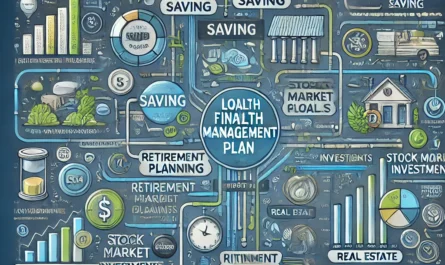Transitioning from wealth accumulation to wealth preservation is a significant financial milestone that requires careful planning and a strategic shift in focus. As individuals move closer to retirement or begin considering long-term financial security, protecting the assets they’ve spent years building becomes just as important—if not more so—than continuing to grow their wealth. This guide will help you navigate the journey from accumulating wealth to preserving it, ensuring your future financial well-being and security.
Understanding Wealth Accumulation
Wealth accumulation is often the primary focus during the early and middle stages of a person’s financial journey. It involves strategies aimed at increasing personal wealth over time, such as investing in stocks, bonds, or real estate, or growing a business. The goal during this phase is often to maximize returns, increase assets, and build capital for future financial freedom.
However, accumulating wealth is a mindset driven by risk-taking and growth, which may not be sustainable as life progresses. For instance, during your working years, you may prioritize aggressive investments to achieve high returns. This growth-oriented mindset contrasts sharply with the goals of wealth preservation, where the focus shifts to minimizing risks and ensuring long-term stability.
What Is Wealth Preservation?
Wealth preservation refers to the process of protecting and maintaining the value of one’s assets over time. The objective is no longer to grow wealth at a fast pace but to ensure that your accumulated wealth lasts, particularly through retirement, and can be passed on to future generations if desired. This phase emphasizes security, capital preservation, and income generation.
Preserving wealth often requires a shift in investment strategies—moving from high-growth, high-risk investments to more stable, income-generating ones. The goal is to create financial certainty, protect against inflation, and avoid market volatility that could jeopardize your financial future.
The Right Time to Transition
One of the key questions people face is knowing when to transition from accumulation to preservation. While there is no universal answer, a general rule of thumb is to begin shifting your focus as you near retirement age or reach significant financial milestones.
For some, this might occur in their late 40s or 50s when retirement planning becomes more immediate. Others may delay this transition depending on their financial goals and risk tolerance. It’s crucial to evaluate factors like retirement age, income needs, and lifestyle choices when deciding the right time for wealth preservation.
Key Differences Between Wealth Accumulation and Preservation
The difference between wealth accumulation and wealth preservation boils down to a change in risk tolerance, time horizons, and financial goals.
During the accumulation phase, investors tend to take on higher risks, hoping for substantial rewards. However, as you move toward wealth preservation, the need to protect your assets against potential losses becomes more pressing. The time horizon also shifts; while in accumulation you might have decades to recover from market downturns, in preservation, protecting what you already have takes priority because your timeline for accessing these funds is much shorter.
Building a Wealth Preservation Strategy
Developing an effective wealth preservation strategy begins with clearly defining your financial goals for the future. This involves assessing how much income you’ll need in retirement, how long you expect your assets to last, and any legacy planning you want to incorporate, such as leaving an inheritance for your family or donating to charity.
Asset protection is a key component of any preservation strategy. This might include investments in safer, more stable asset classes like bonds or dividend-paying stocks, real estate, and annuities. Additionally, it’s essential to ensure your income needs are met, whether through investment income, pensions, or Social Security benefits.
Diversifying Your Investment Portfolio
One of the most effective ways to reduce risk while preserving wealth is through diversification. Spreading your investments across various asset classes—such as stocks, bonds, real estate, and other investment vehicles—can provide a buffer against market volatility and reduce the risk of significant losses.
A diversified portfolio balances the need for growth with the security of wealth preservation. As you age, you may want to adjust the proportion of your investments, shifting from higher-risk growth assets to more conservative ones to protect your wealth. However, some exposure to growth is often still necessary to combat inflation and ensure that your wealth continues to provide a sustainable income.
Managing Market Volatility
Market volatility is an inevitable part of investing, but during the wealth preservation phase, it can be particularly nerve-wracking. To protect your wealth, consider reallocating your assets to more conservative options, such as bonds or treasury securities, which tend to be more stable than stocks.
Additionally, ensure you have a robust financial plan that includes strategies for navigating economic downturns. Having a financial buffer or emergency fund can help prevent the need to withdraw from volatile investments during a market dip, allowing your portfolio time to recover.
The Role of Asset Allocation
Adjusting your asset allocation is essential in the wealth preservation phase. While growth assets such as stocks may have been the focus during accumulation, preserving wealth often means increasing your allocation toward lower-risk investments like bonds, real estate, and cash equivalents.
The key is to find a balance that aligns with your financial goals, risk tolerance, and time horizon. A general strategy might involve gradually increasing the proportion of bonds and fixed-income securities while maintaining some exposure to equities for growth potential.
You Can Also Read : 10 Proven Strategies to Grow Your Wealth Over Time
Protecting Against Inflation
Inflation is one of the silent dangers to wealth preservation. Even a moderate inflation rate can erode the purchasing power of your assets over time, reducing your ability to maintain your standard of living in retirement.
To protect against inflation, consider investments that provide a hedge, such as Treasury Inflation-Protected Securities (TIPS), real estate, or dividend-paying stocks. These assets can help maintain the value of your wealth by providing returns that outpace inflation.



